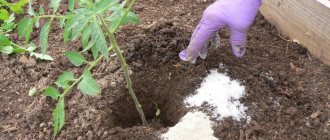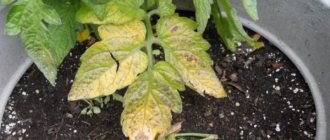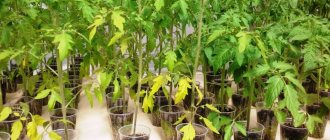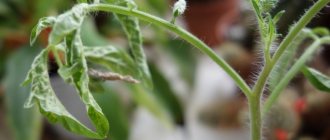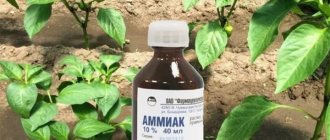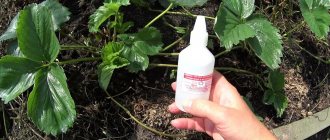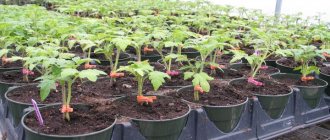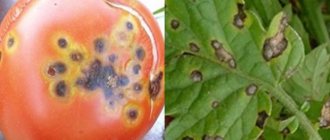What to do, how to help tomatoes
If diseases appear on seedlings, you need to act immediately.
Fusarium appears due to insufficient disinfection or complete lack of treatment of the soil and container where the seedlings grow. Plants dry out even with regular watering. Fungi attack the roots, depriving the stems of the necessary nutrition.
The roots of the plant are removed from the ground and carefully examined. On large seedlings, the vessels in the lower part of the stem become dark brown in color. Heavily infected seedlings with wilted roots and leaves are removed.
To eliminate the disease at the initial stage, the seedlings are treated twice with Fundazol (10 grams per 10 liters of water) and transplanted into new soil disinfected with potassium permanganate. It is very important to disinfect the seedling container into which it will be transplanted.
Blackleg develops when water stagnates. The roots rot, which leads to the death of the plants. The first sign of the disease is blackening of the stems at the root collar.
The disease is difficult to treat; affected plants almost all die. At the initial stage of damage, the seedlings are transplanted into new soil treated with potassium permanganate. Before planting, the roots are treated with crushed charcoal or ash.
The disease can be prevented with the help of preventive measures. When planting, the soil is disinfected with a solution of potassium permanganate. A good option is store-bought ready-made soil mixture. After watering, the soil is sprinkled with sand.
When the seedlings are dense, seedlings are picked.
After thinning, the space between the sprouts is filled with a small amount of disinfected river sand. 3 days after picking, the seedlings recover and begin to grow.
What is a black leg and how to deal with it: video
If the soil is highly acidic, tomato seedlings can be saved only after replanting the plants in a soil mixture deoxidized with wood ash.
Alkaline soil is replaced with fresh soil with the addition of dolomite flour.
Seedlings do not like excess moisture. To protect seedlings from stagnation of moisture in the soil, drainage is installed in the containers.
Holes are pre-made at the bottom of the containers, which allow excess water to flow out into the trays. The accumulated moisture in the trays is poured out. The holes are cleared of soil once every 2 weeks. When moisture stagnates in the soil, the seedlings are not watered at first, and then irrigated with a spray bottle.
Lack of moisture also negatively affects seedlings. Overdried soil crumbles and the supply of nutrients to the root system stops.
The first sign of lack of moisture is the wilting of seedlings. If the watering regime is not restored in time, the leaves begin to dry, which leads to the death of the sprouts. To restore nutrition, seedlings are watered with a small amount of water. Approximately 30 milliliters of water is consumed per plant.
To compensate for the lack of light in the room, the container with seedlings is moved to a bright window, insulated balcony, loggia, or additionally illuminated with a fluorescent lamp or phytolamp. Daylight hours are extended to 12 hours.
Additional illumination of seedlings is carried out in the evening and morning hours, and, if necessary, during the day if the day is cloudy. The lamp should not be turned on at night, as this may harm the plants.
If the sun's rays are too bright and harm the seedlings, cover the glass with white paper, which will protect the delicate leaves from overheating.
With complex fertilizing, phosphorus, nitrogen, and potassium are applied at least 2 times during the development of seedlings, in accordance with the norm. Phosphorus fertilizers are applied a week before transplanting seedlings to a permanent place of growth. All fertilizers are applied in liquid form.
If there is an excess of nitrogen, the dense whitish film on the surface of the earth is removed, and the soil is watered for some time with a solution of sodium humate (15 grams of the drug per bucket of water).
When transplanting seedlings to a permanent place, the seedlings often wither and fall. To prevent this from happening, the plants are pre-hardened. To do this, at night they are placed in a cooler room, without drafts. Ventilation of the room is carried out without seedlings. In stable warm weather, it is placed outside and brought back indoors in the evening. If there is a greenhouse, plants are sent there around the clock.
Causes of yellowing leaves in tomatoes
After germination, tomato seedlings first develop two cotyledon leaves. Then, as they grow, real leaves appear with a color and shape characteristic of a particular variety.
Yellowing and drying of cotyledon leaves is a common phenomenon, indicating that the plant has used up its initial supply of nutrients. Further nutrition occurs through new shoots, true leaves and the root system of tomatoes. Therefore, yellowing of formed shoots and leaves is a signal that the tomatoes have some problems.
Causes:
- insufficient lighting;
- temperature violations;
- lack or excess of moisture;
- nutritional deficiency;
- small volume of container in which tomatoes grow;
- damage to the root system (during a dive);
- the presence of fungi or other pathogens in the soil mixture.
Leaves also turn yellow when plants are planted closely. In this case, tomatoes can grow both in one seedling box and in separate pots. In the second case, the containers with seedlings are placed too tightly on the windowsill and the plants come into contact with each other.
Insufficient lighting
Tomatoes are a light-loving crop, so seedlings are grown on windows, closer to the light. The duration of daylight hours should be from 9 to 12 hours.
On a note! It is best to place seedlings on south-eastern or eastern windows.
In February and March, when there is still little sun, young plants often do not have enough light. This causes the leaves to turn yellow. Closer to May, another problem with lighting may arise: sunburn on tomatoes. This happens especially often with plants on southern windows.
Temperature violations
Tomatoes need warmth, and the temperature must be stable. Changes between day and night lead to leaf shedding and slower growth. Dry air from heating devices, drafts from vents and open doors have a negative effect on plants.
In addition to yellowness, a bluish or purple tint often appears on the leaves and twigs. This is an indicator that the seedlings are exposed to a strong difference in day and night temperatures.
Improper watering
A common cause of yellowing seedlings is excess soil moisture. The soil acquires a sour smell, plaque and whitish spots appear on the surface. In addition to yellowing, tomatoes may develop a dangerous infection - black leg. With the slightest delay in treatment, it is easy to lose all the tomato seedlings.
Prolonged droughts and lack of moisture are also unacceptable for seedlings. With such changes, tomatoes experience stress and slow down their development.
Nutritional deficiency
Tomato seedlings grow quickly in favorable conditions. Seedlings intensively increase green mass, drawing nitrogen from the soil. Balanced soil mixtures for young plants have enough nutrients, but if there is a lack of nitrogen, the leaves will turn yellow and die. The plant actively redistributes nutrition, delivering the necessary substances from old leaves to the cells of new leaves. At the same time, chlorosis develops on the lower leaf blades and they dry out.
The appearance of yellow spots, as well as curling of young foliage on tomatoes, indicates a deficiency of potassium in the soil. If yellowness appears on the leaves along the veins, then this is a signal of magnesium deficiency.
Close planting
Gardeners often sow tomatoes in common seedling boxes and containers. If the plants are picked in time into separate capacious containers, there will be no problems. But it happens that tomatoes remain in the boxes, intertwined with roots.
A large number of seedlings in one container is not only a possible nutritional deficiency, but also a lack of free space for plants and a lack of normal ventilation. In such conditions, tomatoes stretch out and their leaves turn yellow.
The problem also arises when picking plants into cups that are too small, from which the tomatoes quickly grow.
Unsuitable soil
Yellowing and falling of plant leaves is caused by poor-quality soil. Store-bought nutrient mixtures and home-prepared soil for planting seedlings require mandatory disinfection and treatment.
Tomatoes do not grow well in heavy soils with a lot of peat. Such soil is often covered with a salt crust and cakes, forming solid fragments inside the pots. The root system of plants does not receive enough oxygen, which disrupts the nutritional process of tomatoes and leaves turn yellow.
Diseases and pests
Inexperienced gardeners often forget that the cause of yellowing of seedlings at home can be crop diseases, as well as pests. Dangerous for tomatoes:
- blackleg;
- fusarium;
- various rots.
Infections appear under conditions of high humidity, high or, conversely, low temperatures, and dense plantings.
With a black leg, the stems at the bottom become thinner, and a constriction appears. The disease progresses quickly in conditions of high soil moisture, and “mows down” all the seedlings.
With fusarium, the lower leaves begin to turn yellow, then gradually brown spots appear on the top of the seedlings. The stem cut appears brown and the plants wither and die.
On a note! At the first symptoms of the disease, the affected plants are removed from the boxes and destroyed.
Conditions for the growth of healthy tomato seedlings
To grow strong, healthy seedlings, you need to adhere to certain conditions.
To sow seeds and plant tomato seedlings, it is better to take soil mixture purchased at a flower shop. Self-prepared soil, consisting of soil, peat, rotted humus and river sand in proportions 1.5: 1: 1: 0.5. Superphosphate, urea and potash fertilizers are added to the prepared mixture.
The soil mixture must be treated with potassium permanganate or calcined in the oven. For looseness and better moisture permeability, river sand must be added to it.
Before filling the seedling container with soil, it is treated with a hot solution of potassium permanganate.
Before sowing, seeds are treated for 3 hours with immunostimulating drugs, for example Immunocytophyte (a tablet of the drug for 15 grams of water per 5 grams of seeds).
When sowing seeds in prepared soil, they are placed at an equal distance from each other (3-5 centimeters). If possible, they are seated immediately in separate containers or peat tablets.
Picking seedlings is carried out when 2-3 main leaves appear on the sprouts. When transplanting, the main root is pinched, this makes it easier for the seedlings to endure the transplant.
The crops are watered with warm water, after which the sprouts are removed from the soil. During picking, the tips of the roots of the seedlings are pinched off to develop the root system. The seedlings are placed in the holes, the roots are straightened and sprinkled with soil.
If picking is carried out indoors, then the container with seedlings is moved to a heat source, for example, to a heating radiator or air heater to remove excess moisture after transplantation.
If seedlings are picked in a greenhouse, then you can get rid of excess moisture by sprinkling the ground with dry sand or dry sawdust. Sand (sawdust) will absorb moisture within 1 hour, after which it is carefully removed from the beds. The greenhouse must not be ventilated!
Watering the seedlings should be regular and with sufficient water. After watering, the soil is loosened with a thin stick, this helps saturate the roots of the seedlings with oxygen.
Plants are provided with a regular supply of fresh air. When ventilated, the seedlings are transferred to another room. Drafts are unacceptable!
To ensure that the seedlings do not become lethargic, they are provided with stable air and soil temperatures and the required amount of light.
Plants are placed in a room with an air temperature of 20-22 degrees.
Only hatched seedlings are provided with round-the-clock lighting. Plants that are gaining strength need bright light 12 hours a day. This time is enough for them to be fully saturated with nutrients.
To feed tomato seedlings, take 0.5 liters of mullein infusion or chicken droppings and 100 grams of wood ash per bucket of water. Feeding is repeated after 10 days.
You can use the following solution: 30 grams of superphosphate, 20 grams of potassium sulfate, 10 grams of ammonium nitrate per bucket of warm water.
A solution is also used: 40 grams of superphosphate, 25 grams of potassium sulfate per 10 liters of water.
Observing all the conditions, the seedlings grow, become stronger and, when transplanted to a permanent place, quickly take root and grow.
Causes of abnormal development of seedlings
It is possible to grow strong, stocky tomato seedlings with a strong stem and a well-developed root system if comfortable conditions are created for the seedlings and recommendations for sowing and plant picking are followed. Need to:
- use nutritious, moisture- and breathable soil;
- ensure the availability of artificial light sources when there is insufficient natural light;
- perform moderate regular watering;
- provide enough space for each seedling;
- maintain indoor air humidity at 60–80%;
- observe the recommended temperature regime.
Tomato seedlings love fresh air and grow well with regular ventilation. However, drafts can cause seedlings to wilt and even fall.
If the rules for caring for young plants are violated, the seedlings signal possible problems with their appearance. Tomato seedlings should be periodically inspected, since only timely measures will help solve the difficulties that have arisen.
You can grow healthy tomato seedlings by maintaining a balance of light, temperature and humidity.
Which leaves turn yellow on tomatoes?
Before you do anything, if the leaves of tomato seedlings turn yellow, you need to pay attention to what kind of leaves they are: upper, lower or cotyledons.
Lower
The lower leaves not only turn yellow, but also dry out. This happens immediately after landing. The reason is sudden climate change. When they begin to care for a drooping bush, the leaves return to normal in 3-5 days.
Tomato leaves turn yellow
In addition to changing color, the foliage has other signs of illness:
- lethargy;
- the fruits become smaller;
- the edges and tips of the leaves curl.
If these signs are absent and the leaves are yellow, it means that the bush is actively growing. This is normal in late summer (then no intervention is required), but not early in the season. When intensive growth stops, the bush itself will turn green and stop curling its leaves.
Upper
The upper leaves are young, so if they change color and wither, this indicates problems. The yellow color is accompanied by the leaves curling inward. Causes:
- lack of calcium, sulfur, iron, boron and manganese;
- aphid;
- root infection.
These problems do not affect the lower leaves.
Cotyledons
If the cotyledon leaves of tomato seedlings turn yellow, this is due to humidity. Either there is not enough water and the sprouts dry out, or the soil is too moist. Reasons for leaves turning yellow:
- incorrectly selected soil;
- excessive or insufficiently frequent watering;
- lack or excess of nutrients;
- lack of light;
- small distance between bushes.
The cotyledon leaves of tomatoes turn yellow.
Also, in diseased plants, the leaves curl inward.
What to do to save seedlings?
If cases of infection are isolated, the diseased seedling is removed along with a lump of earth, and Fitosporin or a solution of potassium permanganate is injected into the soil with a syringe without a needle.
The seedlings are watered with Bordeaux mixture (1%) or warm water with one of the drugs dissolved in it:
- 1.5–2 g of potassium permanganate per 10 liters of water;
- 5 g of copper sulfate per 10 liters of water.
At the very beginning of the development of blackleg, seedlings can be saved - the seedlings are carefully dug up, the roots are washed in a solution of potassium permanganate or Fitosporin and transplanted into new soil. The air temperature must be brought to normal - no higher than 25 ºC, watering must be reduced, and the seedlings must be ventilated regularly.
Problem four: spots on tomato seedlings
Often white, transparent spots on tomato seedlings occur due to sunburn. Seedlings need sunlight, but direct sunlight can easily burn the leaves. This sometimes happens when seedlings are “unaccustomed” to the sun (during prolonged cloudy weather, for example). In case of aggressive sun, you need to shade the plants with newspapers, and spray the affected leaves with Epin.
Dirty white spots with a dark border on tomato leaves mean that your seedlings are sick with septoria (white spot).
This is a fungal disease that is carried along with the soil and develops at high temperatures or humidity. It is best to remove affected plants. Fungal diseases are difficult to cure and are best avoided. To do this, it is necessary to warm up (or freeze) the seedling soil before planting the seeds. Or carry out preventive treatment of the soil with antifungal drugs.
How to grow the root system
Trichopolum for tomato seedlings
Tomato roots have the ability to form throughout the entire period of plant development. This feature allows you to significantly increase the total volume of roots using certain agricultural techniques.
Tomatoes have a tap root system, which makes it possible to place the roots in the desired direction. Tomatoes are planted using seed and seedling methods. When planted by seeds, the tap stem grows vertically in depth.
Seeds
When growing tomatoes in seedlings, the main root is pinched during picking. Its vertical growth stops, the plant gets the opportunity to grow a large number of lateral processes. Being located close to the surface, they receive more moisture and nutrition.
During the growth of the bush, it is recommended to add fertile substrate to the stem to form new roots. It is useful to hill up with damp soil and add additional nutrition.
An effective technique for increasing yield is growing “bipedal” plants. Seedlings that have reached a height of 12-14 cm and intended for grafting are placed at a distance of 15 cm and inclined towards each other, the roots are turned in opposite directions. Each plant is tied to a support. The three lower leaves on the stems are removed.
The grafting is done two weeks after planting the seedlings in the evening, when the heat has subsided.
Important! Two days before grafting, you need to stop watering so that the plants wilt a little, otherwise the stems will become brittle.
Using a sharp blade treated with alcohol, make 4 cm long cuts on both plants, removing a thin layer of skin. Having connected the places of the cuts, wrap them tightly with a piece of fabric. After 10 days, cut off the weaker stem 5 cm above the graft. The stems must be round in cross-section, otherwise the grafting sites will not grow together well.
Double-rooted tomatoes manage to develop an abundant root system during the growing season, receive double nutrition and form larger fruits.
For grafting, it is better to take tomatoes of the same variety to avoid plant rejection.
Causes and methods of treating yellow leaves on tomato seedlings
Determine the cause of yellowing leaves and learn how to correct it so that your tomato seedlings grow healthy and strong.
| Cause | Solution |
| Excess or lack of water | Determine how much water your seedlings need (see below) |
| Compacted soil | Loosen the soil around plants more often |
| Virus, fungus or bacteria | Read rblogs.ru further for a complete list of solutions to the problem |
| Not enough nutrients | This could be a deficiency of nitrogen, minerals, etc. See below for signs and solutions |
| Lack of sun | Rearrange the seedlings so they receive more sunlight. If this is not possible, arrange additional lighting |
